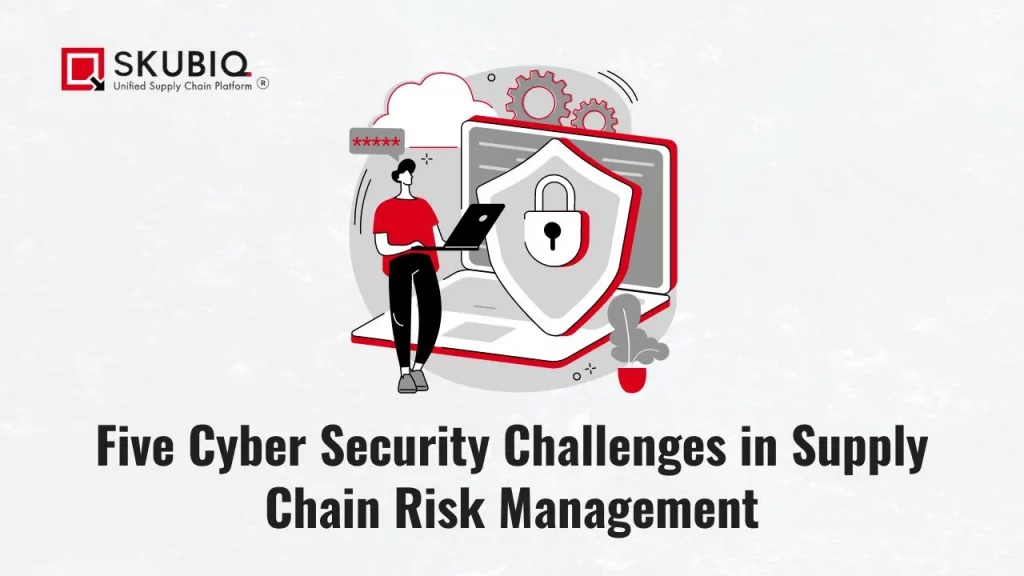Num mundo cada vez mais interligado, a cadeia de abastecimento tornou-se uma área crítica de foco para a segurança cibernética. À medida que as empresas dependem de uma vasta rede de fornecedores, parceiros e prestadores de serviços, a sua exposição a ameaças cibernéticas cresce exponencialmente. Eficaz Gerenciamento de Risco da Cadeia de Suprimentos (SCRM) exige agora uma abordagem robusta para identificar e mitigar os desafios de segurança cibernética. Este artigo explora cinco principais desafios de segurança cibernética que as empresas enfrentam na gestão riscos da cadeia de abastecimento.
1. Riscos de fornecedores terceirizados
Um dos desafios mais significativos de segurança cibernética na gestão de riscos da cadeia de abastecimento é o risco representado por fornecedores terceirizados. As empresas trabalham frequentemente com vários fornecedores e prestadores de serviços, cada um dos quais pode ter acesso a dados ou sistemas sensíveis. Se um fornecedor terceirizado Se as medidas de cibersegurança forem inadequadas, pode tornar-se um elo fraco na cadeia de abastecimento, expondo toda a rede a potenciais ataques cibernéticos.
Principais preocupações:
- Violações de dados: Fornecedores com práticas inadequadas de segurança de dados podem vazar inadvertidamente informações confidenciais, levando a violações de dados.
- Controle de acesso: Controles de acesso inadequados em fornecedores terceirizados podem resultar em acesso não autorizado a sistemas e dados críticos.
- Problemas de conformidade: O não cumprimento dos regulamentos de segurança cibernética por parte dos fornecedores pode levar a problemas legais e repercussões financeiras para a empresa parceira.
Para mitigar os riscos de fornecedores terceiros, as empresas devem realizar uma devida diligência minuciosa, implementar controlos de acesso rigorosos e avaliar regularmente a postura de segurança cibernética dos seus fornecedores.
2. Falta de visibilidade e transparência
Outro grande desafio na segurança cibernética da cadeia de abastecimento é a falta de visibilidade e transparência em todo o mundo. toda a cadeia de abastecimento. As empresas muitas vezes têm uma visão limitada das práticas de segurança cibernética dos seus fornecedores, dificultando a avaliação precisa dos riscos.
Principais preocupações:
- Hidden Vulnerabilities: Lack of visibility into the cybersecurity measures of lower-tier suppliers can leave companies exposed to hidden vulnerabilities.
- Inconsistent Security Standards: Suppliers may adhere to different cybersecurity standards, leading to inconsistencies and potential security gaps in the supply chain.
- Difficulty in Incident Response: Without clear visibility, identifying the source of a cyber incident within the supply chain can be challenging, delaying response and mitigation efforts.
To enhance visibility and transparency, companies should implement comprehensive supply chain mapping, require regular cybersecurity audits from suppliers, and establish clear communication channels for reporting security incidents.
3. Increasing Complexity of Supply Chains
Supply chains have become increasingly complex, involving multiple tiers of suppliers spread across different geographic locations. This complexity introduces a higher risk of cyber threats, as the attack surface expands with each additional supplier and system integrated into the supply chain.
Principais preocupações:
- Expanded Attack Surface: A more complex supply chain offers more entry points for cyber attackers, making it harder to secure the entire network.
- Difficulties in Coordinating Security Efforts: Coordinating cybersecurity efforts across a complex, multi-tiered supply chain is challenging, often leading to inconsistencies in security measures.
- Higher Likelihood of Supply Chain Disruptions: Cyber attacks targeting any part of the supply chain can cause widespread disruptions, affecting the entire operation.
To address this challenge, companies need to simplify and streamline their supply chains where possible, establish clear cybersecurity protocols, and ensure consistent security practices across all tiers of the supply chain.
4. Insider Threats
Insider threats pose a significant challenge to supply chain cybersecurity, as they involve individuals within the organization or its suppliers who misuse their access to compromised systems or data. These threats can be particularly difficult to detect and mitigate because insiders are often trusted with legitimate access to critical systems.
Principais preocupações:
- Malicious Insiders: Employees or contractors with malicious intent can exploit their access to steal sensitive information or sabotage systems.
- Unintentional Insider Risks: Insiders may inadvertently cause security breaches through negligence or lack of cybersecurity awareness.
- Supply Chain Insider Threats: Employees of suppliers or vendors with access to the company’s systems or data can also pose significant risks.
To mitigate insider threats, companies should implement robust access controls, conduct regular employee training on cybersecurity best practices, and monitor for unusual activity that could indicate insider threats.
5. Supply Chain Data Integrity
Maintaining data integrity across the supply chain is crucial for ensuring the accuracy and reliability of information. However, cyber attackers often target supply chain data to manipulate or corrupt it, leading to significant operational disruptions, financial losses, and reputational damage.
Data Tampering
Cyber attackers may alter or manipulate data at any point in the supply chain, leading to incorrect decisions or actions.
Loss of Trust
If data integrity is compromised, it can erode trust between partners and stakeholders within the supply chain.
Operational Disruptions
Corrupted data can lead to operational inefficiencies, product recalls, and supply chain disruptions.
To protect supply chain data integrity, companies should implement strong encryption practices, use blockchain technology for secure data sharing, and regularly verify the accuracy and consistency of supply chain data.
Conclusão
Cybersecurity in supply chain risk management is a multifaceted challenge that requires a proactive and comprehensive approach. By addressing the risks posed by third-party vendors, improving visibility and transparency, managing supply chain complexity, mitigating insider threats, and ensuring data integrity, companies can better protect their supply chains from cyber threats. As supply chains continue to evolve, so too must the strategies used to secure them, ensuring that companies can operate safely and efficiently in an increasingly digital world.



